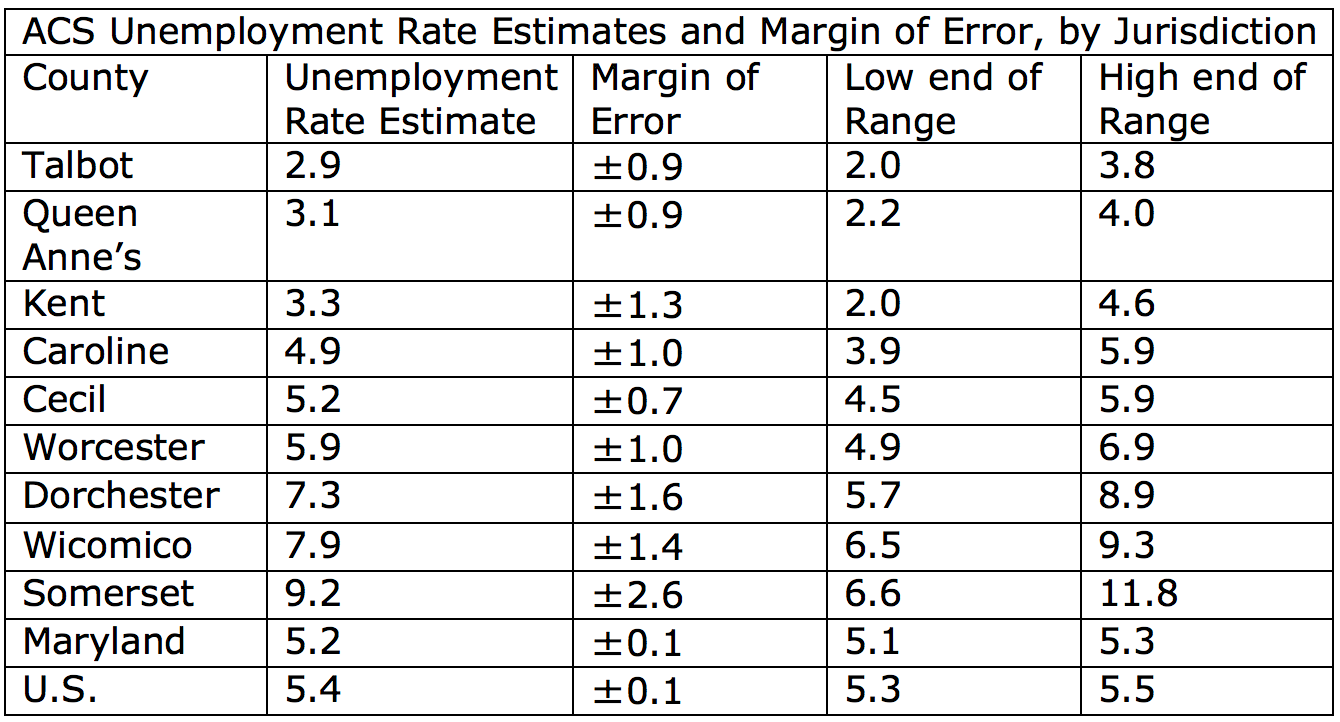Eastern Shore Data Briefs: Three Employment Measures

Our last data brief talked about some demographic measures in Eastern Shore counties. This time we’ll explore a few employment measures.
These data are from the American Community Survey (ACS), a program of the U.S. Census Bureau. ACS replaced the decennial census long form in 2010. ACS asks questions of a representative, randomized sample of about three-and-a-half million residents of the United States to produce yearly estimates of detailed social, demographic, housing, and economic information.
The estimates in the tables below are from ACS 2016-2020. The five-year estimates enable data from smaller jurisdictions — such as Eastern Shore counties — to be released; the ACS is often the only source of these data for rural and small communities.
Questionnaires for ACS are completed over a 12-month period, so respondents report their data at different times during the year. While this aspect of the survey does not usually have an effect on the data collected, it can affect employment data. Employment status is reported as of a “reference week,” that is, the calendar week prior to the date the respondent completed the questionnaire. This methodology accounts for the differences in unemployment rates as calculated by ACS and those reported by the state, which are calculated monthly using employment status as of the 12th of the month.

Mean travel time to work is the average travel time that workers took to get from home to work (one way) during the reference week. Work from home is not included. Travel can be by any mode. Travel time includes time spent waiting for public transportation, picking up passengers and carpools, and time spent in other activities related to getting to work.
According to ACS, average travel time to work has increased in the U.S. almost every year since 2006 (when it was 25 mins); the mean in 2019 was 28 minutes.
It should be no surprise that Queen Anne’s County residents have the longest average commute, as a significant portion of the working population travels across the Bay Bridge to the western shore for work. Travel time for these commuters would include any time waiting in a bridge backup. Please note: the ACS question asks for the time going TO work; if the question were FROM work, Queen Anne’s average travel time would be even longer, as east bound bridge delays are more frequent and longer than west bound.
In the U.S., between 2019 and 2021, the percentage of people primarily working from home tripled from 6% (roughly 9 million people) to 18% (27 million people), according to new 2021 ACS 1-year estimates. Maryland was one of four states with the highest percentage of home-based workers, all about 25% (DC was highest at 48%).
Those of us who live here have first-hand knowledge that this trend existed in the Eastern Shore counties as well; next year’s 5-year ACS estimates will no doubt reflect that.

Median household income is an annual measure. This chart shows income as measured in 2020 inflation-adjusted dollars.
Household income includes more than just earnings — that is, wage, salary, and self-employment income. Additional categories of income include interest, dividends, or net rental income; Social Security income; Supplemental Security income (SSI); public assistance income; retirement income; and any other income that doesn’t fit these listed categories.
Queen Anne’s County has the highest median household income on the Eastern Shore, no doubt reflecting the higher salaries paid on the western shore to its many bridge commuters. Cecil County is second highest; the county’s easy access to I-95 and thus to metropolitan areas to the north and south account for this. Somerset County, the most isolated county, has a median household income less than half of Queen Anne’s.
Maryland’s median household income in 2020 was $87,063 (surpassed by Queen Anne’s by over $9000). The median household income for the U.S. was $71,186 (surpassed by three Shore counties).
Median household income is substantially lower in rural areas than in urban areas, although often a lower cost of living mitigates this deficit. Nationally, since 2007, rural median income has averaged 25% below the urban median.
Not all Shore counties are considered rural, however. Five Shore counties were reclassified as metro/urban when they were incorporated into Metropolitan Statistical Areas (MSAs) by the federal government in 2013: Cecil (part of the Philadelphia MSA); Queen Anne’s (part of the Baltimore MSA); and Wicomico, Worcester, and Somerset (part of the Salisbury MSA). If you’ve ever driven in Somerset County you may disagree with this urban characterization.
The other four Shore counties — Caroline, Dorchester, Kent, and Talbot — are still considered rural, not persistent poverty counties. More on that next time.

Unemployment rates on the Shore varied as estimated by the ACS 2016-2020, from a low of 2.9% in Talbot County to 9.2% in Somerset. Maryland’s unemployment rate was 5.2% for the same period; the U.S. rate was 5.4%.
Unemployment rate is calculated much as you would expect, including all civilians 16 years and older, unless their work activity consisted of only work around the house or unpaid volunteer work, or unless they were institutionalized.
A person is considered employed if they were at work during the reference week, or were temporarily absent from their job.
A person is considered unemployed if they were neither at work nor temporarily absent, and were actively looking for work, and were available to start a job. (Anyone not satisfying all three criteria is not considered unemployed.)
The unemployment rate is calculated as the number of unemployed people divided by the civilian labor force (employed + unemployed).
ACS is based on a sample, rather than all people and households, so the rates and quantities reported are calculated estimates, not actual values. This means that there is a degree of uncertainty associated with them, known as sampling error. In general, the larger the sample, the smaller the level of sampling error. The Census Bureau calculates a margin of error (MOE) for each estimate; this provides a range of values within which the actual, “real-world” value is likely to fall.
This chart shows the estimates from the chart above, plus the range of values calculated using the margin of error.

In other words, while the published unemployment rate estimate for Talbot County is 2.9%, there is a calculated margin of error equal to ±0.9%, meaning that the actual unemployment rate in Talbot will fall somewhere between 2.0% and 3.8%. Notice that the margin of error is very low in Maryland and the U.S. because the number of respondents is higher. The margin of error increases as the size of the sample decreases; Somerset County had a small sample, thus the ±2.6% margin of error. (See Appendix Table for margin of error values.)
That’s it for this edition of Eastern Shore Data Briefs. Next time we’ll take a look at some community characteristics of Eastern Shore counties.
Appendix: Table of unemployment rate estimates and margins of error, American Community Survey, 2016-2020:

Jan Plotczyk spent 25 years as a survey and education statistician with the federal government, at the Census Bureau and the National Center for Education Statistics. She retired to Rock Hall.
Common Sense for the Eastern Shore







